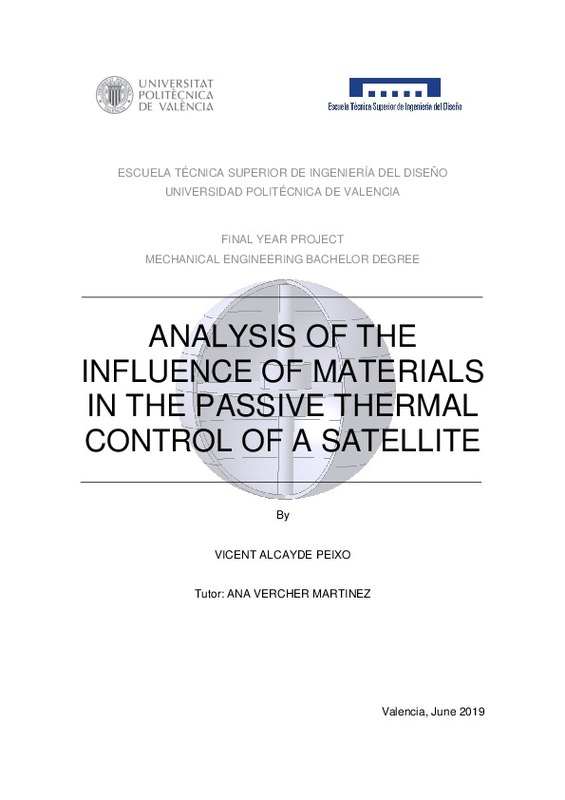JavaScript is disabled for your browser. Some features of this site may not work without it.
Buscar en RiuNet
Listar
Mi cuenta
Estadísticas
Ayuda RiuNet
Admin. UPV
Analysis of the influence of the different materials on the passive thermal control of a satellite
Mostrar el registro sencillo del ítem
Ficheros en el ítem
| dc.contributor.advisor | Vercher Martínez, Ana
|
es_ES |
| dc.contributor.author | Alcayde Peixó, Vicent
|
es_ES |
| dc.date.accessioned | 2019-07-25T10:39:28Z | |
| dc.date.available | 2019-07-25T10:39:28Z | |
| dc.date.created | 2019-07-04 | |
| dc.date.issued | 2019-07-25 | es_ES |
| dc.identifier.uri | http://hdl.handle.net/10251/124197 | |
| dc.description.abstract | [ES] El control térmico de un satélite consiste en establecer los parámetros térmicos necesarios involucrados en el proceso de transferencia del calor por radiación y conducción para acotar el rango de temperaturas al que serán expuestos los distintos elementos. Si el rango conseguido incluye temperaturas no admisibles por los componentes, entonces, es necesario efectuar un control externo (control activo) en el que actúan elementos adicionales como calefactores o intercambiadores de calor. El presente TFG aborda exclusivamente el control pasivo. Para ello, se programará en Matlab las ecuaciones de gobierno correspondientes al equilibrio nodal. La resolución de dichas ecuaciones dará como solución la temperatura de equilibrio que alcanza cada región considerada isoterma teniendo en cuenta la radiación solar, el albedo, la radiación planetaria, la radiación sobre las superficies provenientes de otras del propio satélite, fuentes de calor interna, el proceso de conducción de calor y la radiación de dichas superficies al espacio exterior. Mediante la programación de esta herramienta, el alumno abordará el estudio de la influencia de diferentes materiales empleados en la fabricación del satélite desde el punto de vista de su comportamiento térmico. | es_ES |
| dc.description.abstract | [CA] El control tèrmic d’un satèl·lit consistix en establir uns paràmetres tèrmics necessaris involucrats en el procés de transferència del calorper radiació i conducció per a acotar el rang de temperatures al que seran exposats els distints elements. Si el rang aconseguit inclou temperatures no admissibles per als components, doncs, hi serà necessari efectuar un control extern (o control actiu) en el que actuaran elements addicionals com calefactors o intercanviadors de calor.El present TFG aborda exclusivament el control passiu. Per a portar-lo a terme, es programaran amb Matlab les equacions de govern corresponents al equilibri nodal. La resolució de les nomenades equacions donarà com a solució la temperatura de equilibri que aconseguirà cada regió considerada isoterma tenint en conter la radiació solar, el albedo, la radiació planetària, la radiació provinent de altres superfícies del propi satèl·lit, fonts de calor internes, el procés de conducció de calor i la radiació de la nomenades superfícies al espai exterior.Mitjançant la programació d’aquesta ferramenta, l’alume abordarà l’estudi de l’influencia de diferent materials utilitzats en la fabricació d’un satèl·lit des de el punt de vista del comportament tèrmic. | es_ES |
| dc.description.abstract | [EN] The thermal control of a satellite consists on establishing the necessary thermal parameters involved in the process of heat transfer by radiation or conduction to be able to delimit the range of temperatures to which the different components will be exposed. If the obtained range involves temperatures that the different components of the satellite are unable to cope with, therefore, an external control (or active control) is needed, being required some additional elements, such as heaters or heat exchangers. The following TFG is solely focused on the passive control. The governing equations corresponding to the nodal equilibrium necessary for the aforementioned control will be programmed in Matlab. The resolution of these equations will provide as a result the equilibrium temperature that each area of the surface of the satellite reaches. All these surfaces will be considered isothermal, taking into account all the factors that affect them, such as solar radiation, albedo, planetary radiation, the radiation coming from other nodal surfaces of the same satellite, the heat conduction and the radiation of these nodal surfaces to the outer space. Through the programming of this tool, the student will tackle the study of the influence of different materials used in the manufacturing of a satellite, from the standpoint of thermal behavior. | es_ES |
| dc.format.extent | 134 | es_ES |
| dc.language | Inglés | es_ES |
| dc.publisher | Universitat Politècnica de València | es_ES |
| dc.rights | Reconocimiento - No comercial (by-nc) | es_ES |
| dc.subject | Control térmico pasivo | es_ES |
| dc.subject | radiación | es_ES |
| dc.subject | satélite | es_ES |
| dc.subject | Passive thermal control | es_ES |
| dc.subject | radiation | es_ES |
| dc.subject | satellite | es_ES |
| dc.subject.classification | INGENIERIA MECANICA | es_ES |
| dc.subject.other | Grado en Ingeniería Mecánica-Grau en Enginyeria Mecànica | es_ES |
| dc.title | Analysis of the influence of the different materials on the passive thermal control of a satellite | es_ES |
| dc.type | Proyecto/Trabajo fin de carrera/grado | es_ES |
| dc.rights.accessRights | Abierto | es_ES |
| dc.contributor.affiliation | Universitat Politècnica de València. Departamento de Ingeniería Mecánica y de Materiales - Departament d'Enginyeria Mecànica i de Materials | es_ES |
| dc.contributor.affiliation | Universitat Politècnica de València. Escuela Técnica Superior de Ingeniería del Diseño - Escola Tècnica Superior d'Enginyeria del Disseny | es_ES |
| dc.description.bibliographicCitation | Alcayde Peixó, V. (2019). Analysis of the influence of the different materials on the passive thermal control of a satellite. Universitat Politècnica de València. http://hdl.handle.net/10251/124197 | es_ES |
| dc.description.accrualMethod | TFGM | es_ES |
| dc.relation.pasarela | TFGM\111279 | es_ES |
Este ítem aparece en la(s) siguiente(s) colección(ones)
-
ETSID - Trabajos académicos [8906]
Escuela Técnica Superior de Ingeniería del Diseño






